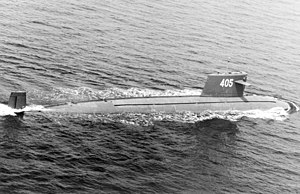
The RUR-5 ASROC is an all-weather, all sea-conditions anti-submarine missile system. Developed by the United States Navy in the 1950s, it was deployed in the 1960s, updated in the 1990s, and eventually installed on over 200 USN surface ships, specifically cruisers, destroyers, and frigates. The ASROC has been deployed on scores of warships of many other navies, including Canada, Germany, Italy, Japan, the Republic of China, Greece, Pakistan and others.

The Seawolf class is a class of nuclear-powered, fast attack submarines (SSN) in service with the United States Navy. The class was the intended successor to the Los Angeles class, and design work began in 1983. A fleet of 29 submarines was to be built over a ten-year period, but that was reduced to 12 submarines. The end of the Cold War and budget constraints led to the cancellation of any further additions to the fleet in 1995, leaving the Seawolf class limited to just three boats. This, in turn, led to the design of the smaller Virginia class. The Seawolf class cost about $3 billion per unit, making it the most expensive United States Navy fast attack submarine and second most expensive submarine ever, after the French Triomphant-class nuclear-powered ballistic missile submarines.

The Type 212A is a class of diesel-electric submarine developed by Howaldtswerke-Deutsche Werft AG (HDW) for the German Navy, and the Italian Navy where it is known as the Todaro class. It features diesel propulsion and an additional air-independent propulsion (AIP) system using Siemens proton-exchange membrane (PEM) compressed hydrogen fuel cells. The submarines can operate at high speed on diesel power or switch to the AIP system for silent slow cruising, staying submerged for up to three weeks with little exhaust heat. The system is also said to be vibration-free and virtually undetectable.

An attack submarine or hunter-killer submarine is a submarine specifically designed for the purpose of attacking and sinking other submarines, surface combatants and merchant vessels. In the Soviet and Russian navies they were and are called "multi-purpose submarines". They are also used to protect friendly surface combatants and missile submarines. Some attack subs are also armed with cruise missiles, increasing the scope of their potential missions to include land targets.
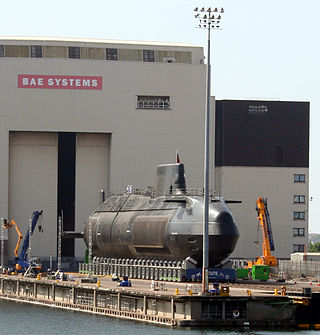
A nuclear submarine is a submarine powered by a nuclear reactor, but not necessarily nuclear-armed. Nuclear submarines have considerable performance advantages over "conventional" submarines. Nuclear propulsion, being completely independent of air, frees the submarine from the need to surface frequently, as is necessary for conventional submarines. The large amount of power generated by a nuclear reactor allows nuclear submarines to operate at high speed for long periods, and the long interval between refuelings grants a range virtually unlimited, making the only limits on voyage times being imposed by such factors as the need to restock food or other consumables.

The Project 633 class is a class of Soviet diesel-electric submarine, built between 1957 and 1961. A Chinese variant, Type 033, was built in China from 1962 to 1984.

The Dolphin class is a diesel-electric submarine developed in Israel and constructed by Howaldtswerke-Deutsche Werft AG (HDW) in Kiel, Germany, for the Israeli Navy. The first boats of the class were based on the export-only German 209-class submarines, but modified and enlarged. The Dolphin 1 sub-class is slightly larger than the German Navy Type 212 in length and displacement. The three newer air-independent propulsion (AIP) equipped boats are similar to the Type 212 vessels in underwater endurance, but are 12 metres (39 ft) longer, nearly 500 tonnes heavier in submerged displacement and have a larger crew than either the Type 212 or the Type 214.
The Type 092 submarine was the first nuclear-powered ballistic missile submarine (SSBN) deployed by the People's Liberation Army Navy Submarine Force.

The Type 094 is a class of nuclear ballistic missile submarines developed by China for the People's Liberation Army Navy Submarine Force. The Type 094 succeeds the Type 092 submarine and precedes the Type 096 submarine, which is under development.
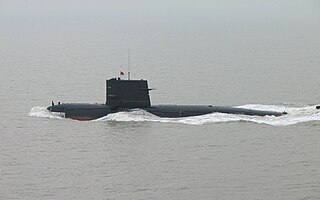
The Type 039 submarine is a class of diesel-electric submarines of the People's Liberation Army Navy. The class is the first diesel-electric submarine to be fully developed within China and also the first Chinese diesel-electric submarine to use the teardrop hull shape.
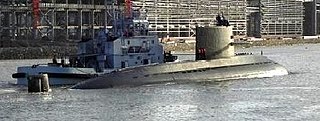
The Type 039A submarine is a class of diesel-electric submarine in China's People's Liberation Army Navy. It is China's first AIP powered submarine and presumed to be one of the quietest diesel-electric submarine classes in service. This class is the successor of the Type 039 submarine. The official Chinese designation is 039A as the ship is based on the 039 class, but as the 039A has very little resemblance to the 039 it is commonly referred to as the Type 041. The class is designed to replace the aging Type 033 and the older Type 035 submarines that previously formed the backbone of the conventional submarine force.
The People's Liberation Army Navy (PLAN) is the naval branch of the People's Liberation Army (PLA), the armed forces of the People's Republic of China. The PLAN force consists of approximately 250,000 men and over a hundred major combat vessels, organized into three fleets: the North Sea Fleet, the East Sea Fleet, and the South Sea Fleet.
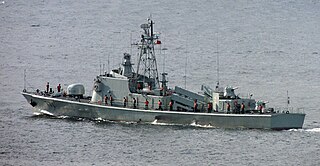
The Type 037 corvette is a series 400–500 ton corvette type classes in service with the People's Liberation Army Navy. Unlike western navies, the People's Liberation Army Navy does not have dedicated patrol boats in its inventory. Instead, a large variety of corvette type classes, in the form of missile boats and submarine chasers fulfill the tasks of patrolling China's territorial waters. The Egyptian Navy operates eight vessels.

The Zulfiquar-class frigate, also known as F-22P or in English: Sword class, is a class of multi-mission guided missile frigates, in service with the Pakistan Navy. The class is based on an updated model of the Chinese design, the Type 053H3. The frigates were designed and built jointly in Hudong–Zhonghua Shipbuilding in China and the KS&EW Ltd. in Pakistan.

The People's Liberation Army Navy Submarine Force (PLANSF) is the submarine service of the People's Liberation Army Navy. It consists of all types of submarines in operational service organized into three fleets: the North Sea Fleet, the East Sea Fleet, and the South Sea Fleet. Submarines have long been one of the three focuses of the People's Liberation Army Navy, and when the decision was made in late 2006 to concentrate on building other principal surface combatants to strengthen the air defense and to further delay the construction of aircraft carriers due to insufficient air cover, submarines will continue to play the lead dominant role in the assault force for the PLAN. Currently, PLANSF operates a fleet of 66 submarines which include nuclear as well as conventional submarines.
The Type 095 is a planned class of third-generation nuclear attack submarines for the People's Liberation Army Navy (PLAN) of China. It is anticipated that the Type 095 submarine will have a substantially reduced acoustic signature, within an improved hull design.
The Type 093 submarine is a class of nuclear-powered attack submarines constructed by the People's Republic of China for the People's Liberation Army Navy.
The Type 035 submarine is a class of diesel-electric submarines of the People's Liberation Army Navy. The Type 035 is a heavily improved redesign of the older Type 033 submarines, which were built in China from 1962 to 1984.

Huang Xuhua is a Chinese mechanical engineer, and the second chief designer for the country's first generation of nuclear submarines. He is director emeritus of the Wuhan-based 719 Research Institute of China Shipbuilding Industry Corporation, and is an academician of the Chinese Academy of Engineering. His name was classified until 1987.

Changzheng 1 (401) is a Type 091 nuclear attack submarine of the People's Liberation Army Navy.

